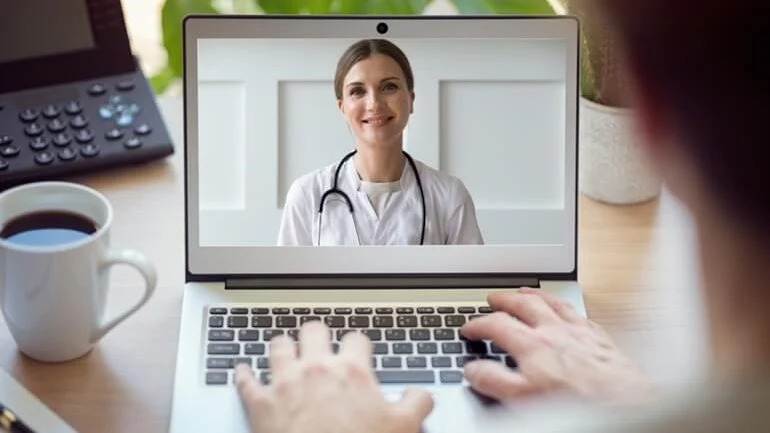
The Health Resources and Services Administration (HRSA) of the U.S. Department of Health and Human Services defines telehealth as the use of electronic information and telecommunications technologies to support and promote long-distance clinical health care, patient and professional health-related education, public health and health administration.
Telehealth applications include:
- Live (synchronous) videoconferencing: a two-way audiovisual link between a patient and a care provider
- Store-and-forward (asynchronous) videoconferencing: transmission of a recorded health history to a health practitioner, usually a specialist.
- Remote patient monitoring (RPM): the use of connected electronic tools to record personal health and medical data in one location for review by a provider in another location, usually at a different time.
- Mobile health (mHealth): health care and public health information provided through mobile devices. The information may include general educational information, targeted texts, and notifications about disease outbreaks.
Why Telemedicine Now?
After many years of improvements, emails, phone calls, video chats and other telemedicine applications are gradually supplementing or replacing some types of office visits, much like electronic communication and technology have revolutionized other services such as preparing taxes, booking travel and banking.
For years, telemedicine has been used to serve patients in rural areas because of the challenges presented by distance and transportation. However, with the rapid expansion of wireless connectivity and advancement in technology resources combined with consumer demand for information and immediacy, you can expect telemedicine to become a more prevalent medical protocol for the treatment, monitoring and management of patient health in a much more rapid fashion.
Because of the recent outbreak of COVID-19 and the related regulatory restrictions enacted to slow its spread, many physicians quickly enabled Telemedicine techniques to allow patients to adhere to quarantine/social distancing restrictions while still being able to receive consultations and treatments from their physician.
Average morning commute time in Dallas and Ft Worth is one of the highest in the US. Televisits allow patients the ease of having a one-on-one appointment without a lengthy drive.
Benefits of Telemedicine
Under the current constraints of social distancing, closings, and further efforts to prevent the spread of COVID-19, Telemedicine is rapidly becoming more mainstream and will likely impact the way in which many physicians practice medicine going forward. With the Dallas-Fort Worth Metroplex under a shelter in place order, DHAT is doing everything we can to serve our patients virtually when possible.
- Accessibility – Telemedicine can provide high-quality health care services to patients living in rural areas and those with transportation or mobility difficulties. At the same time, telemedicine enables health care practices to cater to a much broader set of patients than those living locally.
- Convenience – regardless of a patient’s location, provided they have wireless service and/or an Internet connection, they can participate in a telemedicine visit with their healthcare provider. The use of telemedicine can also reduce the time away from work for many patients.
- Efficiencies for Patients – The use of Telemedicine can greatly increase efficiencies for both patients and physicians by enabling a more convenient method and access to care.
- Follow-up Visits – Follow-up visits are a critical part of comprehensive healthcare. However, they’re not always very convenient. Making follow-up visits more convenient for patients via a televisit, impacts positive outcomes for both the patient and physician.
- Diagnostic Test Review – Delivering a diagnostic test result via televisit instead of a phone call or voice-mail helps to ensure the patient understands the information and reacting in an expected manner.
- Care for Chronic Conditions – Enabling a televisit for patients with chronic conditions eases the load for everyone involved (patient, caregiver and physician) while enabling more frequent monitoring and greater compliance with the treatment plan.
- Post-hospital Follow-Up – A televisit is a great way to check on a patient who is still recovering from a surgery or hospitalization without making them physically come to the office.
- Medication Monitoring – A quick televisit is a great way to ensure treatments with prescribed medications are working as expected without side effects, especially for those patients with long-term treatments.
- Quality of Care – Studies have shown that telemedicine can be as effective as in-person care and contributes to improved patient outcomes vs. the traditional approach. The telemedicine factors contributing to improved outcomes include:
- More Focused One-On-One Conversations – A telemedicine encounter eliminates the distractions of a busy medical office environment, enabling the patient and the provider to focus on the present concern.
- Fewer Obstacles to Obtaining Treatment – Telemedicine makes it easier for patients to receive care regardless of their location.
- A Broader Approach to Providing Treatment – The option of a televisit makes it easier for the provider and patient to craft a comprehensive treatment plan that may address situations in the home or needs that are not always met when discussing in the physician’s office environment.
- Reduced Risk of Exposure to Contaminants – Despite everyone’s best efforts there’s a risk that the illness will spread to others in a doctor’s office.
- Cost – In most cases, the cost for patients is the same or similar to that of an office visit. Overall healthcare efficiencies and cost are impacted positively due to fewer transports to hospital ER’s, hospital admissions, shorter hospital stays, reduced travel times, and improved management of chronic diseases.
Not Without Challenges
As with any advancement, whether it be technology, manufacturing, transportation, finance or healthcare, challenges are expected, and telemedicine is no exception. However, be very clear that telemedicine is not intended as a complete replacement of traditional healthcare practices, but a complimentary service to enable more comprehensive and accessible healthcare to patients.
Some concerns with telemedicine include:
- Diagnosis – For some conditions, it’s not always possible to make a diagnosis or facilitate treatment through anything but an in-person examination.
- Insurance – Not all telemedicine services are covered by private insurance payers or reimbursed by federal programs. Medicare, for example, typically places specific restrictions on telehealth services. However, at the time of the COVID-19 pandemic, Medicare, along with many insurance providers agreed to allow payment of telemedicine visits regardless of location.
- Privacy issues – A clinician providing telemedicine services must adhere to confidentiality standards set forth by the Health Insurance Portability and Accountability Act External link (HIPAA), just as they would with patient information in their office.
Telemedicine has a huge role to play in medicine today and in the future. For patients, they gain greater access and convenience to healthcare and healthcare providers, increased time-savings and ultimately improved outcomes with the use of telemedicine. For physicians, they gain the ability to reach, treat and impact the health of a broader audience of patients, create patient-centered differentiators in the marketplace and ultimately generate improved healthcare outcomes. The economic impact and wide use of telemedicine has yet to be realized, but it is anticipated to impact more positively than negatively for the entire healthcare system.


